The new bandage healed diabetic ulcers 30 per cent faster than in mice without the bandage.

Professor Guillermo Ameer holds the small, thin, flexible device in his hand. (Supplied)
Researchers have developed a first-of-its-kind small, flexible and stretchable bandage that accelerates healing by 30 percent through the delivery of electrotherapy directly to the wound site.
Developed by a team from Northwestern University — their findings have been published in the journal Science Advances — the stretchable bandage was used in an animal study, and found it healed diabetic ulcers 30 percent faster in mice using bandage than those that did not.
The bandage also actively monitors the healing process and then harmlessly dissolves — electrodes and all — into the body after it is no longer needed.
The new device could be a powerful tool for patients with diabetes, whose ulcers can lead to various complications, including amputated limbs or even death.
It marks the first bioresorbable bandage capable of delivering electrotherapy and the first example of a smart regenerative system.
“When a person develops a wound, the goal is always to close that wound as quickly as possible,” said Northwestern’s Guillermo A Ameer, who co-led the study, in a statement.
“Otherwise, an open wound is susceptible to infection. And, for people with diabetes, infections are even harder to treat and more dangerous,” he added.
“For these patients, there is a major unmet need for cost-effective solutions that really work for them. Our new bandage is cost-effective, easy-to-apply, adaptable, comfortable and efficient at closing wounds to prevent infections and further complications.”
“Although it’s an electronic device, the active components that interface with the wound bed are entirely resorbable,” said Northwestern’s John A Rogers, who co-led the study.
One side of the smart regenerative system contains two electrodes: A tiny flower-shaped electrode that sits right on top of the wound bed and a ring-shaped electrode that sits on healthy tissue to surround the entire wound.
The other side of the device contains an energy-harvesting coil to power the system and a near-field communication (NFC) system to wirelessly transport data in real time, the researchers said.
They also included sensors that can assess how well the wound is healing.
By measuring the resistance of the electrical current across the wound, physicians can monitor progress, the researchers said.
A gradual decrease of current measurement relates directly to the healing process. If the current remains high, then physicians know something is wrong, they added.
The researchers were curious to see if electrical stimulation therapy could help close these stubborn wounds.
According to Ameer, injuries can disrupt the body’s normal electrical signals. By applying electrical stimulation, it restores the body’s normal signals, attracting new cells to migrate to the wound bed.
“Our body relies on electrical signals to function,” Ameer said. “We tried to restore or promote a more normal electrical environment across the wound. We observed that cells rapidly migrated into the wound and regenerated skin tissue in the area. The new skin tissue included new blood vessels, and inflammation was subdued.”
Historically, clinicians have used electrotherapy for healing. But most of that equipment includes wired, bulky apparatuses that can only be used under supervision in a hospital setting.
The team also included sensors that can assess how well the wound is healing. By measuring the resistance of the electrical current across the wound, physicians can monitor progress.
A gradual decrease of current measurement relates directly to the healing process. So, if the current remains high, then physicians know something is wrong.
By building in these capabilities, the device can be operated remotely without wires. From afar, a physician can decide when to apply the electrical stimulation and can monitor the wound’s healing progress.
“As a wound tries to heal, it produces a moist environment,” Ameer said.
“Then, as it heals, it should dry up. Moisture alters the current, so we are able to detect that by tracking electrical resistance in the wound. Then, we can collect that information and transmit it wirelessly.
“With wound care management, we ideally want the wound to close within a month. If it takes longer, that delay can raise concerns.”

Apr 23, 2024

Apr 23, 2024

Apr 23, 2024

Apr 22, 2024

Apr 22, 2024